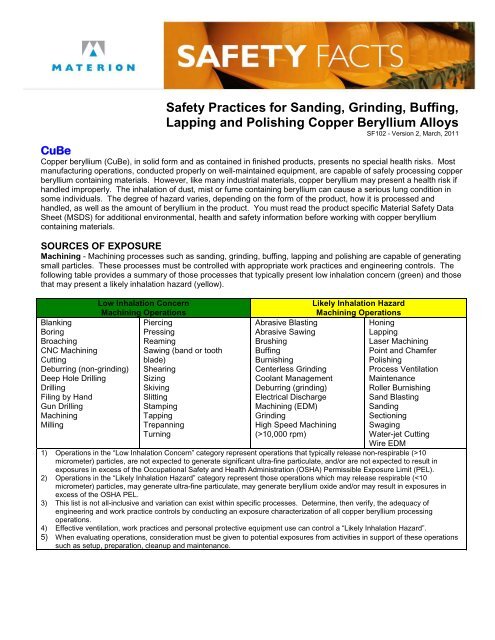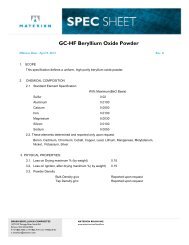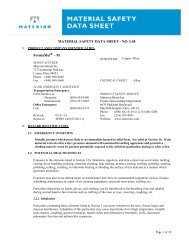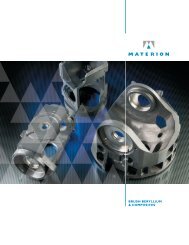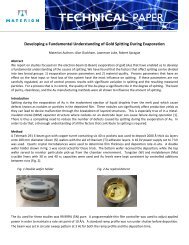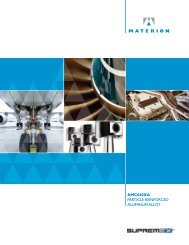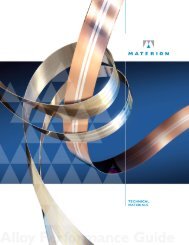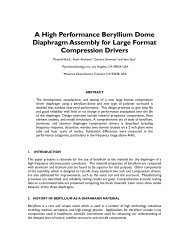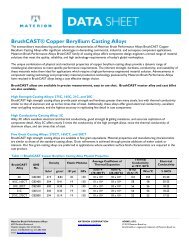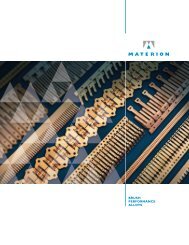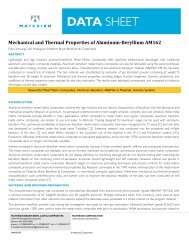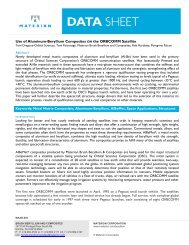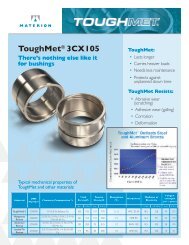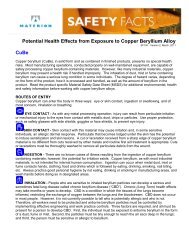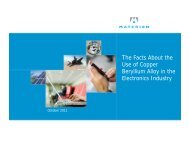Safety Practices for Sanding, Grinding, Buffing, Lapping and - Materion
Safety Practices for Sanding, Grinding, Buffing, Lapping and - Materion
Safety Practices for Sanding, Grinding, Buffing, Lapping and - Materion
Create successful ePaper yourself
Turn your PDF publications into a flip-book with our unique Google optimized e-Paper software.
CuBeCopper beryllium (CuBe), in solid <strong>for</strong>m <strong>and</strong> as contained in finished products, presents no special health risks. Mostmanufacturing operations, conducted properly on well-maintained equipment, are capable of safely processing copperberyllium containing materials. However, like many industrial materials, copper beryllium may present a health risk ifh<strong>and</strong>led improperly. The inhalation of dust, mist or fume containing beryllium can cause a serious lung condition insome individuals. The degree of hazard varies, depending on the <strong>for</strong>m of the product, how it is processed <strong>and</strong>h<strong>and</strong>led, as well as the amount of beryllium in the product. You must read the product specific Material <strong>Safety</strong> DataSheet (MSDS) <strong>for</strong> additional environmental, health <strong>and</strong> safety in<strong>for</strong>mation be<strong>for</strong>e working with copper berylliumcontaining materials.SOURCES OF EXPOSUREMachining - Machining processes such as s<strong>and</strong>ing, grinding, buffing, lapping <strong>and</strong> polishing are capable of generatingsmall particles. These processes must be controlled with appropriate work practices <strong>and</strong> engineering controls. Thefollowing table provides a summary of those processes that typically present low inhalation concern (green) <strong>and</strong> thosethat may present a likely inhalation hazard (yellow).BlankingBoringBroachingCNC MachiningCuttingDeburring (non-grinding)Deep Hole DrillingDrillingFiling by H<strong>and</strong>Gun DrillingMachiningMillingLow Inhalation ConcernMachining Operations<strong>Safety</strong> <strong>Practices</strong> <strong>for</strong> <strong>S<strong>and</strong>ing</strong>, <strong>Grinding</strong>, <strong>Buffing</strong>,<strong>Lapping</strong> <strong>and</strong> Polishing Copper Beryllium AlloysSF102 - Version 2, March, 2011PiercingPressingReamingSawing (b<strong>and</strong> or toothblade)ShearingSizingSkivingSlittingStampingTappingTrepanningTurningAbrasive BlastingAbrasive SawingBrushing<strong>Buffing</strong>BurnishingCenterless <strong>Grinding</strong>Coolant ManagementDeburring (grinding)Electrical DischargeMachining (EDM)<strong>Grinding</strong>High Speed Machining(>10,000 rpm)Likely Inhalation HazardMachining OperationsHoning<strong>Lapping</strong>Laser MachiningPoint <strong>and</strong> ChamferPolishingProcess VentilationMaintenanceRoller BurnishingS<strong>and</strong> Blasting<strong>S<strong>and</strong>ing</strong>SectioningSwagingWater-jet CuttingWire EDM1) Operations in the “Low Inhalation Concern” category represent operations that typically release non-respirable (>10micrometer) particles, are not expected to generate significant ultra-fine particulate, <strong>and</strong>/or are not expected to result inexposures in excess of the Occupational <strong>Safety</strong> <strong>and</strong> Health Administration (OSHA) Permissible Exposure Limit (PEL).2) Operations in the “Likely Inhalation Hazard” category represent those operations which may release respirable (
WORK PRACTICES & CONTROL MEASURESSome combination of the following control measures may be required when s<strong>and</strong>ing, grinding, buffing, lapping <strong>and</strong>polishing copper beryllium alloys:Wet Methods• The proper use of machining lubricants as a flood or in heavy flows is usually an effective method <strong>for</strong> controllingthe airborne generation of copper beryllium particles.• Care should be given to lubricant containment that prevents excessive splashing onto floor areas or operators’clothing.• Inadequate coolant flow <strong>and</strong> higher tooling speeds may require additional containment <strong>and</strong> ventilation controls.• Please note that the recycling of liquid lubricant/coolant containing finely divided copper beryllium in suspensioncan result in the concentration building to a point where the particulate becomes airborne during use.• Machining lubricant should be filtered, settled, centrifuged, or changed regularly to reduce the accumulation of fineparticles.Exhaust Ventilation• Local exhaust ventilation is not necessary <strong>for</strong> machining processes which produce only large (>0.0005”), nonrespirablechips.• Local exhaust ventilation must be used on dust producing operations when lubricants or coolants are not beingused or are not effective in controlling the release of airborne dust.• The type <strong>and</strong> capacity of local exhaust ventilation required will depend upon the speed of particle generation. Forexample: h<strong>and</strong> s<strong>and</strong>ing operations produce relatively slow moving particles, while powered grinders <strong>and</strong> roto tooloperations produce very fast moving particles.• Positioning of a close capture, high velocity ventilation duct/hood at the point of particle generation on a stationarygrinder is critical to the system’s effectiveness. The duct/hood must be positioned as close as possible to thesource <strong>and</strong> in line with the direction of particle travel.• The dust generated when using h<strong>and</strong>held grinders or roto tools can be very difficult to control due to the r<strong>and</strong>omnature of particle generation. H<strong>and</strong>held grinders <strong>and</strong> roto tools are generally used in a ventilated partial or fullenclosure designed to draw particles away from the operator. Alternative methods to h<strong>and</strong> grinders such as filingor wet s<strong>and</strong>ing should be used where possible.• Disruption of the airflow in the area of a local exhaust inlet, such as by a man cooling fan, should be avoided.• Ventilation equipment should be checked regularly to ensure it is functioning properly.• Ventilation training is recommended <strong>for</strong> all users.• To be effective, ventilation systems should be designed, installed <strong>and</strong> maintained by qualified professionals.Speeds/Feeds/Tooling• These machining variables must be considered when determining the extent <strong>and</strong> type of engineering controls <strong>and</strong>work practices which may be required.• Similar to the machining speed discussed above, stock feed rates can be an important factor in determiningwhether a process will generate airborne particles.• Tooling condition is another important variable. Sharp-tooled machining processes generally produce only largechips while dull tooling may produce a mixture of large <strong>and</strong> smaller chips.• Strict control of process speeds/feeds <strong>and</strong> tooling condition will assist in reducing airborne particle generation frommachining processes.Respiratory Protection• Whenever possible, appropriate work practices, use of local exhaust ventilation or other engineering controls arethe preferred methods <strong>for</strong> controlling exposure to airborne particles. When these methods are ineffective, or arebeing developed <strong>and</strong> potential exposures are above the occupational limits, approved respirators must be used asspecified by an Industrial Hygienist or other qualified professional.• Respirator users must be medically evaluated to determine if they are physically capable of wearing a respirator.• Quantitative <strong>and</strong>/or qualitative fit testing <strong>and</strong> respirator training must be satisfactorily completed by all personnelprior to respirator use.• Users of any style respirator must be clean shaven on those areas of the face where the respirator seal contactsthe face.• Pressure-dem<strong>and</strong> airline respirators are required when per<strong>for</strong>ming jobs where a potential <strong>for</strong> high exposure exists,such as changing filters in a baghouse air cleaning device.
Protective Clothing• Protective overgarments or work clothing must be worn by persons who may come in contact with dusts, fumes orpowders during activities such as grinding, s<strong>and</strong>ing, furnace rebuilding, air cleaning equipment filter changes,maintenance, furnace tending, etc.• Used disposable clothing should be containerized <strong>and</strong> disposed of in a manner which prevents airborne exposureduring subsequent h<strong>and</strong>ling activities.• Contaminated work clothing <strong>and</strong> overgarments must be managed in such a manner to prevent secondary airborneexposure to family or laundry personnel h<strong>and</strong>ling soiled work clothing.• Never use compressed air to clean work clothing.Housekeeping• <strong>S<strong>and</strong>ing</strong>, grinding, buffing, lapping or polishing copper beryllium can deposit fine dust containing beryllium on thesurfaces of the fabricated part.• Fabricated parts should be kept clean between processing steps to avoid potential re-suspension of fine particlesinto the air.• Copper beryllium machining equipment <strong>and</strong> associated support systems (e.g., dust collectors, heat treat furnaces,coolant trays <strong>and</strong> reservoirs) should be cleaned on a regular basis to prevent the accumulation of copper berylliumcontaining materials.• The use of compressed air or brooms <strong>for</strong> cleaning dust must be prohibited. Such activity can result inunnecessary airborne dust exposure.• Wet cleaning <strong>and</strong> vacuuming are effective methods <strong>for</strong> cleaning machining <strong>and</strong> support equipment.• Rags, towels or wipes used to dry or wipe parts clean should not be allowed to dry <strong>and</strong> must be maintained in aclosed container. Rags <strong>and</strong> towels should not be reused. They should be containerized <strong>and</strong> disposed of in amanner which prevents airborne exposure during subsequently h<strong>and</strong>ling activities.• Portable vacuums should be of a type equipped with High Efficiency Particulate Air (HEPA) rated filters.• Special care must be taken when using polishing or lapping compounds. Such compounds should not be reuseddue to the potential <strong>for</strong> cross contamination to other materials. The used compounds should not be allowed to dryout, during or after completion of the job.Maintenance• Under certain conditions the repair or maintenance of equipment can generate airborne particles.• Protecting workers can require the use of specific work practices or procedures involving the combined use ofventilation, wet <strong>and</strong> vacuum cleaning methods, respiratory protection, decontamination, special protective clothing,<strong>and</strong> when necessary, restricted work zones.• Detailed procedures <strong>for</strong> safely maintaining the process equipment <strong>and</strong> ventilation systems should be developed.• All operators <strong>and</strong> maintenance personnel need to be trained in the established procedures prior to per<strong>for</strong>mingmaintenance or service activities. The procedure should detail the use of wet methods or vacuuming, ventilation<strong>and</strong> appropriate personal protective equipment required to prevent exposure to airborne particles.Workplace Exposure Characterization• Air samples should be taken <strong>for</strong> all operations where a potential <strong>for</strong> beryllium exposure exists.• Air monitoring is the primary method <strong>for</strong> determining the degree of exposure <strong>and</strong> effectiveness of engineering <strong>and</strong>work practice controls.• Characterization of worker exposure should only be per<strong>for</strong>med by trained personnel.Recycling• Copper beryllium machining scrap should be kept segregated from other metals to retain its higher value as arecyclable material.• <strong>Materion</strong> Brush Inc. purchases clean, segregated copper beryllium scrap at a premium above mixed copper alloys(routine amounts of lubricant are not a problem).Disposal• Copper beryllium wastes are not considered hazardous under federal regulations.• When spent products are declared solid wastes (no longer recyclable), they must be labeled, managed <strong>and</strong>disposed of, in accordance with federal, state <strong>and</strong> local requirements.• Some copper beryllium products contain specific metals (e.g., chromium, lead) that are regulated waste materials.• Used polishing or lapping compounds should be maintained in a moist condition (no free liquid) during collection<strong>and</strong> disposal, by double bagging in plastic to prevent it from drying out <strong>and</strong> potentially becoming airborne. Thebags should be placed in a DOT approved container <strong>and</strong> appropriately labeled prior to shipment.
ADDITIONAL INFORMATIONThe in<strong>for</strong>mation contained in this <strong>Safety</strong> Facts applies only to the subject referenced in the title. Read the MSDSspecific to the products in use at your facility <strong>for</strong> more detailed environmental, health <strong>and</strong> safety guidance. MSDSs canbe obtained by contacting the <strong>Materion</strong> Brush Inc. Product <strong>Safety</strong> Hotline at (800) 862-4118 or visit our website atwww.materion.com.Additional in<strong>for</strong>mation can also be obtained by contacting a <strong>Materion</strong> Brush Inc. Sales Representative or:Product Stewardship Department<strong>Materion</strong> Brush Inc.6070 Parkl<strong>and</strong> BoulevardMayfield Heights, OH 44124(800) 862-4118


